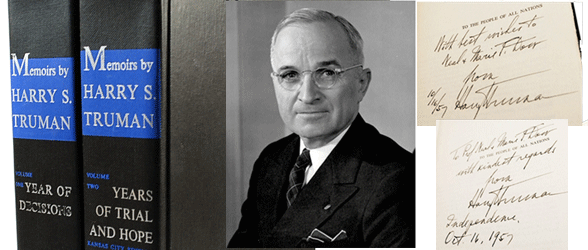Click here to view our Presidents Day 2020 selection of signed and rare books.
With Presidents Day today Feb. 17th in the states, it is only fitting to delve into the world of collecting presidential autographs. Washington’s Birthday is a United States federal holiday celebrated on the third Monday of February in honor of George Washington, the first President of the United States.
With several history-making presidents in recent decades and an unprecedented global interest in the current presidency, now is a great time to discuss the fascinating and addictive hobby of collecting presidential autographs.
The Essentials
Becoming a collector of presidential signatures is a hobby that can bring significant enjoyment and historical significance to you and your family. Just like each of our presidents brought his own style and philosophy to the office, the personalities of our former presidents are often reflected in their distinctive signatures. This historical relevance and insight is one of the many rewarding aspects of locating and obtaining a specific presidential signature.
Why Presidential Autographs Make Great Collectibles
When it comes to signature collecting, knowledge definitely gives you power. So get out your research glasses and hit the library, your local bookstore, a collectors group, or any other available source of information to help you learn as much as possible about which signatures you want, establishing the appropriate value of any given signature, what to look for, and what to avoid.

Here are a few key pointers to get you started:
Everything matters when it comes to valuation. Quality, condition, authenticity, document type, age, and rarity are just a few things you must consider when deciding whether to add a signature to your collection.
Quality counts. Damage to the document, including paper deterioration, smudges, rips or tears, water stains, or any other degradation of the material will significantly reduce the value of a signature. The quality of the actual signature is also a factor, so look for signatures that are high quality, representative of the president’s style, and legible.
Not all signatures are created equal. While auto-pen signatures are considered official representations of the president, they are of almost no value to collectors since they are machine-generated facsimiles instead of handwritten, authentic signings. Another factor for the value of a signature is what type of document was signed. A signature on an inconsequential document is worth far less than a signature on an important or noted document.
Older is better. Older signatures are more rare and harder to find, which increases their value. However, one of the fun activities of this hobby, and a good starting point for new collectors, is locating signatures from recent presidents that will show significant increases in value as they age.
For example, obtaining a letter or book signed by President Obama should be relatively inexpensive now, but due to his popularity and significance, the value of that signature has a good likelihood of increasing in time. With the four most valuable signatures (Washington, Adams, Jefferson, and Lincoln) easily costing $5,000 to $10,000 or more, many new collectors like to start with the smaller investments associated with more recent presidents.
Related category – Click here to browse all signed presidential volumes.